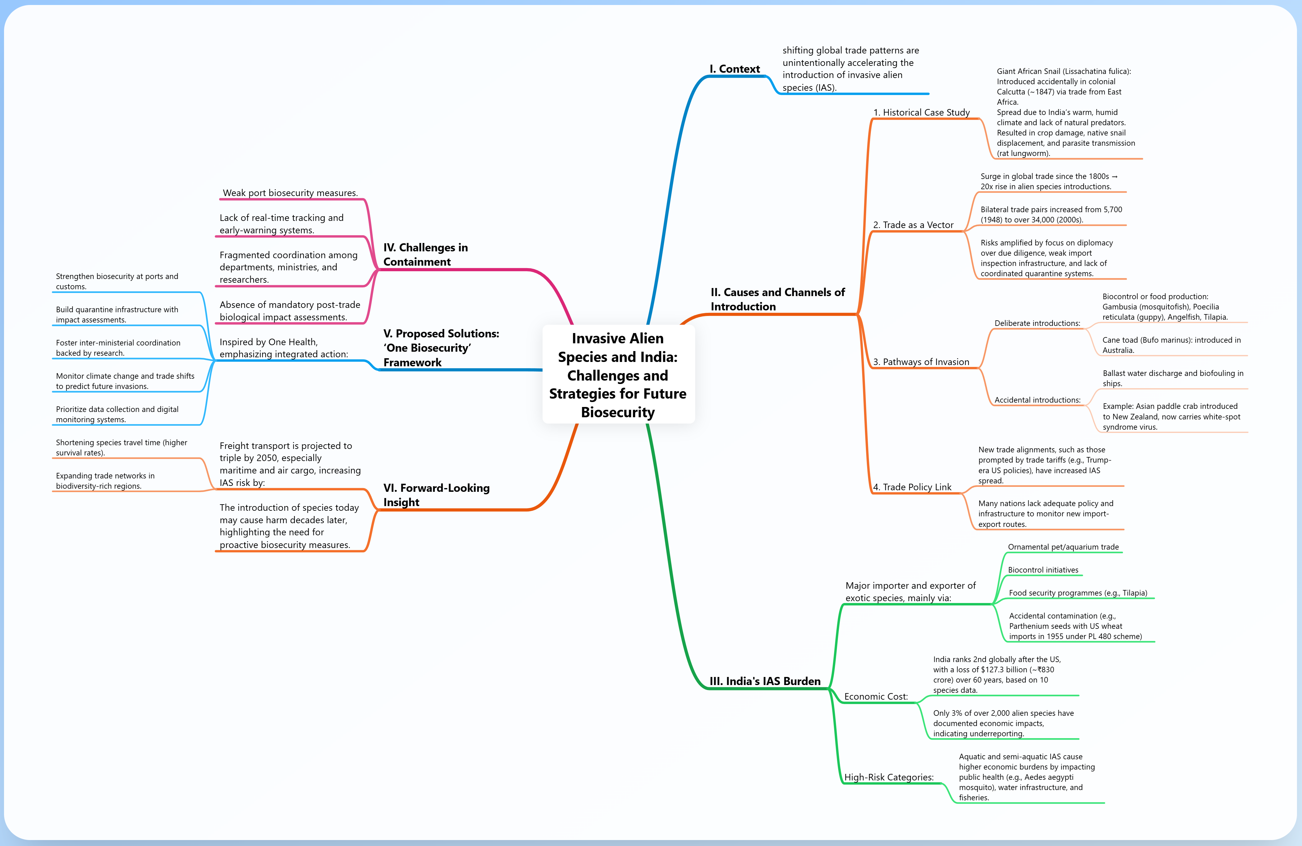Trade and Invasive Alien Species (IAS) in India

-
Trade liberalisation and shifting global trade patterns are unintentionally accelerating the introduction of invasive alien species (IAS).
-
These species threaten biodiversity, ecosystems, food security, public health, and the economy.
Causes and Channels of Introduction
1. Historical Case Study
-
Giant African Snail (Lissachatina fulica):
-
Introduced accidentally in colonial Calcutta (~1847) via trade from East Africa.
-
Spread due to India’s warm, humid climate and lack of natural predators.
-
Resulted in crop damage, native snail displacement, and parasite transmission (rat lungworm).
-
2. Trade as a Vector
-
Surge in global trade since the 1800s → 20x rise in alien species introductions.
-
Bilateral trade pairs grew from 5,700 (1948) to over 34,000 (2000s).
-
New trade ties increase risk due to:
-
Focus on diplomacy over due diligence
-
Weak infrastructure for import inspections
-
Lack of coordinated quarantine systems
-
3. Pathways of Invasion
-
Deliberate introductions (biocontrol or food production):
-
Gambusia (mosquitofish), Poecilia reticulata (guppy), Angelfish, Tilapia
-
Bufo marinus (cane toad in Australia)
-
-
Accidental introductions:
-
Ballast water discharge and biofouling in ships
-
Example: Asian paddle crab introduced to New Zealand, now carries white-spot syndrome virus
-
4. Trade Policy Link
-
Trade tariffs (e.g., Trump-era US policies) led to new trade alignments, increasing IAS spread.
-
Some nations may lack policy and infrastructure to monitor new import-export routes.
India's IAS Burden
-
India is a major importer and exporter of exotic species.
-
Entry mostly via:
-
Ornamental pet/aquarium trade
-
Biocontrol initiatives
-
Food security programmes (e.g., Tilapia)
-
Accidental contamination (e.g., Parthenium seeds with US wheat imports in 1955 under PL 480 scheme)
-
Economic Cost
-
India ranks 2nd globally (after the US) in financial losses from IAS.
-
$127.3 billion lost over 60 years (₹830 crore), based on data from just 10 species.
-
Only 3% of 2,000+ alien species have documented economic impacts—indicating major underreporting.
High-Risk Categories
-
Aquatic & semi-aquatic IAS impose higher fiscal burden due to:
-
Impact on public health (e.g., Aedes aegypti, the yellow fever mosquito)
-
Water infrastructure
-
Fisheries
-
Challenges in Containment
-
Weak port biosecurity
-
Lack of real-time tracking and early-warning systems
-
Fragmentation between departments, ministries, and researchers
-
No mandatory post-trade biological impact assessments
Proposed Solutions: ‘One Biosecurity’ Framework
-
Inspired by One Health, it emphasizes integrated action on invasive species:
-
Strengthen biosecurity at ports and customs points
-
Create quarantine infrastructure with mandatory impact assessments
-
Develop inter-ministerial coordination and research-backed decision-making
-
Track climate change and trade shifts to forecast future invasions
-
Prioritize data collection and digital monitoring systems
-
Forward-Looking Insight
-
Freight transport is projected to triple by 2050, especially maritime and air cargo.
-
This will increase IAS risk by:
-
Shortening travel time (higher survival of species)
-
Expanding trade networks in biodiversity-rich regions
-
-
What is introduced today may manifest harm decades later—as seen with past IAS introductions. Proactive biosecurity is essential.
